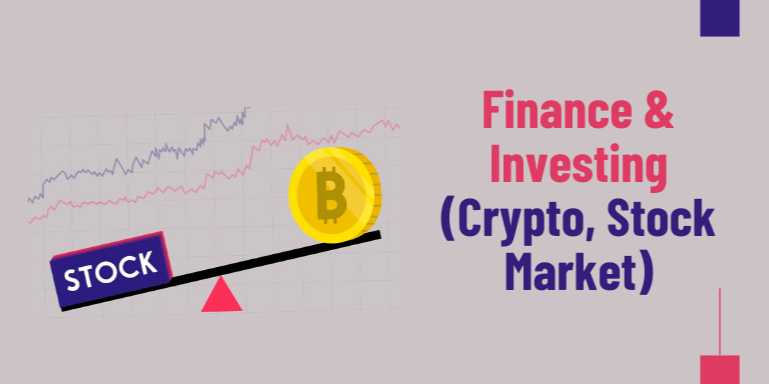Finance & Investing in 2025: Mastering Crypto, Stock Market Strategies, and Smart Wealth Growth

Overview
💰 Why Finance and
Investing Matter More Than Ever
In a world driven by economic uncertainty, inflation
volatility, and rapid digital innovation, understanding finance and
investing is no longer a luxury—it’s a necessity. Whether you’re a
21-year-old building your first savings plan or a 40-year-old seeking financial
independence, how you manage and grow your money defines your future freedom.
2025 has brought unprecedented access to financial tools and
platforms. From mobile stock-trading apps and crypto exchanges to robo-advisors
and DeFi protocols, investing is now global, decentralized, and digitized.
However, access alone doesn’t guarantee success. Without proper
financial literacy and strategy, these tools can lead to losses just as easily
as gains.
This guide aims to demystify personal finance and
investing—especially in two of the most relevant domains today: the stock
market and cryptocurrency.
🧠 Understanding the
Fundamentals of Finance
Before diving into investments, every individual must
understand the basics of personal finance:
- Budgeting:
Knowing how much you earn vs. spend
- Saving:
Creating an emergency fund and short-term goals
- Debt
Management: Avoiding high-interest loans and credit pitfalls
- Financial
Goals: Retirement, education, property, or freedom
- Risk
Tolerance: Knowing how much loss you can handle
Personal finance is the foundation. Once you're
stable, you can explore investment options to grow your wealth.
📈 The Stock Market –
Traditional but Time-Tested
The stock market remains a staple of long-term wealth
generation. When you buy stocks, you buy a piece of a company. If that company
grows, so does your investment.
🔍 Types of Stock Market
Investments:
- Individual
Stocks: Buying shares of companies like Apple, Tesla, or Amazon
- ETFs
(Exchange-Traded Funds): A basket of stocks (e.g., S&P 500 ETF)
- Mutual
Funds: Actively managed funds pooled from many investors
- REITs:
Real estate investment trusts offering dividend income
- Dividend
Stocks: Regular payouts to shareholders
📊 Advantages of Stock
Market Investing:
- High
historical returns (7–10% annually on average)
- Compound
growth over time
- Liquidity
and transparency
- Regulated
markets reduce fraud risk
💡 Strategies for
Successful Stock Investing:
|
Strategy |
Description |
|
Value Investing |
Buying undervalued
companies (Warren Buffett style) |
|
Growth Investing |
Investing in
companies expected to grow rapidly |
|
Dividend Investing |
Focusing on stocks
that pay out regular income |
|
Index Fund Investing |
Passive
investment in entire markets (e.g., S&P 500) |
|
Swing/Day Trading |
Short-term
buying/selling based on price movements (high risk) |
To start, use apps like Robinhood, Webull, Zerodha,
or Fidelity, and study platforms like Investopedia or Seeking
Alpha.
🌐 Cryptocurrency – The
New Frontier of Finance
Crypto has evolved from a fringe experiment to a
full-fledged asset class with its own rules, innovations, and risks. By 2025,
the crypto market has matured, yet remains volatile and speculative.
🔍 Popular Crypto Assets:
- Bitcoin
(BTC): Digital gold and store of value
- Ethereum
(ETH): Smart contracts and decentralized apps
- Solana,
Cardano, Polkadot: Competing smart contract platforms
- Stablecoins:
Pegged to fiat currency (e.g., USDC, USDT)
- DeFi
Tokens: Used in decentralized finance platforms (Aave, Uniswap)
💡 Where Crypto Shines:
- Borderless
transactions
- No
intermediaries or banks
- Smart
contracts (self-executing agreements)
- Tokenization
of assets
- Passive
income via staking, yield farming
📉 Crypto Risks:
- Extreme
volatility (prices can drop 30–50% quickly)
- Regulatory
uncertainty
- Scams,
rug pulls, and exchange failures
- Tech
complexity and wallet security
Always DYOR (Do Your Own Research) before investing.
🧩 Comparing Stocks and
Crypto
|
Aspect |
Stock Market |
Cryptocurrency |
|
Regulation |
Highly regulated by
SEC, SEBI, etc. |
Lightly regulated or
decentralized |
|
Volatility |
Moderate |
High |
|
Accessibility |
Widely available
globally |
Requires wallets &
understanding |
|
Liquidity |
High |
Varies by
token and exchange |
|
Use Case |
Equity ownership in
companies |
Digital money, smart
contracts, DeFi |
|
Risk Level |
Lower
(relatively stable) |
Higher (more
speculative) |
🛠️ Tools for Modern
Investors
|
Tool Type |
Examples |
|
Portfolio Tracking |
CoinStats, Delta, M1
Finance |
|
Research & Education |
Morningstar,
Investopedia, CoinMarketCap |
|
News & Alerts |
Bloomberg, CoinDesk,
Twitter/X Feeds |
|
Security |
Ledger (cold
wallets), 2FA tools |
|
Robo-Advisors |
Betterment,
Wealthfront, Groww |
🧠 Risk Management and
Smart Practices
- Diversification:
Don’t put all your money in one asset
- Dollar-Cost
Averaging: Invest small amounts consistently over time
- Emergency
Fund First: Never invest money you can't afford to lose
- Avoid
Hype Investing: Don’t fall for pump-and-dump traps
- Use
Stop-Losses: Especially in crypto and short-term trading
🎯 The Future of
Investing: 2025 and Beyond
- AI-Powered
Trading: Predictive algorithms assist portfolio decisions
- Tokenization
of Real Assets: Stocks, real estate, and even art on the blockchain
- Sustainable
and Ethical Investing: ESG-focused funds are growing
- Micro-Investing:
Fractional shares and low-fee apps increase accessibility
- Metaverse
& Web3: New economy opportunities through digital assets
🔚 Final Thoughts
Whether you choose stocks for long-term reliability or
crypto for high-growth potential, the core principle remains the same: Financial
literacy leads to financial freedom.
In 2025, the power to manage, grow, and control your wealth
is in your hands—literally. But it's not about chasing the hottest trends. It’s
about informed decisions, steady strategy, and consistent learning.
The smartest investor isn’t the one who bets big—it’s the
one who thinks long.
FAQs
Posted on 09 May 2025, this text provides information on Finance & Investing (Crypto, Stock Market). Please note that while accuracy is prioritized, the data presented might not be entirely correct or up-to-date. This information is offered for general knowledge and informational purposes only, and should not be considered as a substitute for professional advice.



Comments(1)